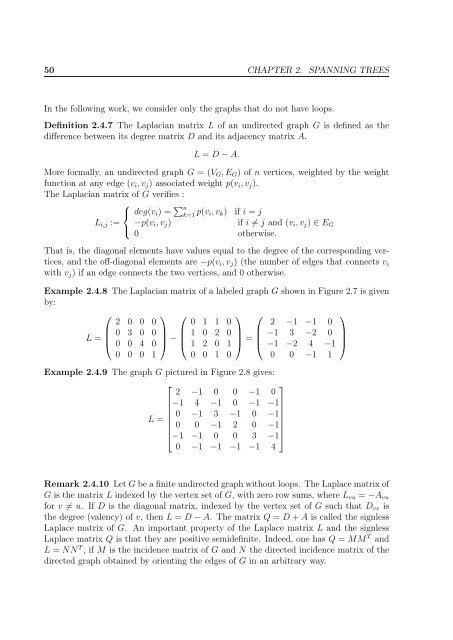enumeration of the number of spanning trees in some ... - Toubkal
enumeration of the number of spanning trees in some ... - Toubkal
enumeration of the number of spanning trees in some ... - Toubkal
Create successful ePaper yourself
Turn your PDF publications into a flip-book with our unique Google optimized e-Paper software.
50 CHAPTER 2. SPANNING TREESIn <strong>the</strong> follow<strong>in</strong>g work, we consider only <strong>the</strong> graphs that do not have loops.Def<strong>in</strong>ition 2.4.7 The Laplacian matrix L <strong>of</strong> an undirected graph G is def<strong>in</strong>ed as <strong>the</strong>difference between its degree matrix D and its adjacency matrix A.L = D − A.More formally, an undirected graph G = (V G , E G ) <strong>of</strong> n vertices, weighted by <strong>the</strong> weightfunction at any edge (v i , v j ) associated weight p(v i , v j ).The Laplacian matrix <strong>of</strong> G verifies :⎧⎨ deg(v i ) = ∑ nk=1 p(v i, v k ) if i = jL i,j := −p(v i , v j )if i ≠ j and (v i , v j ) ∈ E G⎩0 o<strong>the</strong>rwise.That is, <strong>the</strong> diagonal elements have values equal to <strong>the</strong> degree <strong>of</strong> <strong>the</strong> correspond<strong>in</strong>g vertices,and <strong>the</strong> <strong>of</strong>f-diagonal elements are −p(v i , v j ) (<strong>the</strong> <strong>number</strong> <strong>of</strong> edges that connects v iwith v j ) if an edge connects <strong>the</strong> two vertices, and 0 o<strong>the</strong>rwise.Example 2.4.8 The Laplacian matrix <strong>of</strong> a labeled graph G shown <strong>in</strong> Figure 2.7 is givenby:⎛⎞ ⎛⎞ ⎛⎞2 0 0 0 0 1 1 0 2 −1 −1 0L = ⎜ 0 3 0 0⎟⎝ 0 0 4 0 ⎠ − ⎜ 1 0 2 0⎟⎝ 1 2 0 1 ⎠ = ⎜ −1 3 −2 0⎟⎝ −1 −2 4 −1 ⎠0 0 0 1 0 0 1 0 0 0 −1 1Example 2.4.9 The graph G pictured <strong>in</strong> Figure 2.8 gives:⎡⎤2 −1 0 0 −1 0−1 4 −1 0 −1 −1L =0 −1 3 −1 0 −1⎢ 0 0 −1 2 0 −1⎥⎣−1 −1 0 0 3 −1⎦0 −1 −1 −1 −1 4Remark 2.4.10 Let G be a f<strong>in</strong>ite undirected graph without loops. The Laplace matrix <strong>of</strong>G is <strong>the</strong> matrix L <strong>in</strong>dexed by <strong>the</strong> vertex set <strong>of</strong> G, with zero row sums, where L vu = −A vufor v ≠ u. If D is <strong>the</strong> diagonal matrix, <strong>in</strong>dexed by <strong>the</strong> vertex set <strong>of</strong> G such that D vv is<strong>the</strong> degree (valency) <strong>of</strong> v, <strong>the</strong>n L = D − A. The matrix Q = D + A is called <strong>the</strong> signlessLaplace matrix <strong>of</strong> G. An important property <strong>of</strong> <strong>the</strong> Laplace matrix L and <strong>the</strong> signlessLaplace matrix Q is that <strong>the</strong>y are positive semidef<strong>in</strong>ite. Indeed, one has Q = MM T andL = NN T , if M is <strong>the</strong> <strong>in</strong>cidence matrix <strong>of</strong> G and N <strong>the</strong> directed <strong>in</strong>cidence matrix <strong>of</strong> <strong>the</strong>directed graph obta<strong>in</strong>ed by orient<strong>in</strong>g <strong>the</strong> edges <strong>of</strong> G <strong>in</strong> an arbitrary way.

















